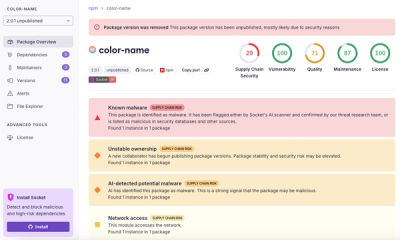
Product
Introducing Pull Request Stories to Help Security Teams Track Supply Chain Risks
Socket’s new Pull Request Stories give security teams clear visibility into dependency risks and outcomes across scanned pull requests.
aws-liveness
Advanced tools
AWS Liveness tools.
npm i --save aws-liveness
const AWSLiveness = require('aws-liveness');
const { DynamoDB } = require('aws-sdk');
const awsLiveness = new AWSLiveness();
const dynamoDBClient = new DynamoDB();
// ping and wait services up to 10 seconds
awsLiveness.waitForServices({
clients: [dynamoDBClient],
waitSeconds: 10
})
.then(() => console.log('services liveness ok'))
.catch(console.error);
// ping a service
awsLiveness.ping({ client: dynamoDBClient })
.then(() => console.log('dynamodb ping success'))
.catch(console.error);
You can customize and/or extend aws-liveness tools to fit your application needs.
const AWSLiveness = require('aws-liveness');
const { DynamoDB } = require('aws-sdk');
class MyCustomService {
async fetchSomeData () {
return { foo: 'bar' }
}
}
const customServices = [{
test: client => client instanceof DynamoDB,
ping: client => client.describeTable({ TableName: 'Foo' }).promise()
}, {
test: client => client instanceof MyCustomService,
ping: client => client.fetchSomeData()
}]
const awsLiveness = new AWSLiveness({ services: customServices });
const dynamoDBClient = new DynamoDB();
const myCustomService = new MyCustomService();
awsLiveness.ping({ client: dynamoDBClient })
.then(() => console.log('dynamodb ping success'))
.catch(console.error);
awsLiveness.ping({ client: myCustomService })
.then(() => console.log('my custom service ping success'))
.catch(console.error);
AWS Liveness uses debug module internally to log information about ping requests and services status. Logging is turned off by default and can be conditionally turned on by setting the DEBUG environment variable equals to aws-liveness.
You can use this module to ensure that LocalStack services are up and running before you test and/or start your application.
// ping-localstack.js
const dynamoDBClient = new DynamoDB({
endpoint: process.env.DYNAMODB_ENDPOINT
});
if (require.main === module) {
awsLiveness.waitForServices({
clients: [dynamoDBClient],
waitSeconds: process.env.WAIT_SECONDS || 10
})
.catch(console.error);
}
{
"scripts": {
"localstack": "docker run -it -p 4569:4569 -p 9999:8080 --rm localstack/localstack",
"localstack-wait": "AWS_ACCESS_KEY_ID=fakeid AWS_SECRET_ACCESS_KEY=fakekey node ping-localstack.js",
"start": "node app.js",
"test-e2e": "AWS_ACCESS_KEY_ID=fakeid AWS_SECRET_ACCESS_KEY=fakekey mocha test-e2e/**/*.test.js",
}
}
DYNAMODB_ENDPOINT=http://localhost:4569 npm run localstack-wait && npm run test-e2e
Commits to master must be done through a Pull Request and Squash and Merge option.
Add a title and body that follows the Conventional Commits Specification.
FAQs
AWS Liveness tools
The npm package aws-liveness receives a total of 4 weekly downloads. As such, aws-liveness popularity was classified as not popular.
We found that aws-liveness demonstrated a not healthy version release cadence and project activity because the last version was released a year ago. It has 1 open source maintainer collaborating on the project.
Did you know?

Socket for GitHub automatically highlights issues in each pull request and monitors the health of all your open source dependencies. Discover the contents of your packages and block harmful activity before you install or update your dependencies.

Product
Socket’s new Pull Request Stories give security teams clear visibility into dependency risks and outcomes across scanned pull requests.

Research
/Security News
npm author Qix’s account was compromised, with malicious versions of popular packages like chalk-template, color-convert, and strip-ansi published.

Research
Four npm packages disguised as cryptographic tools steal developer credentials and send them to attacker-controlled Telegram infrastructure.